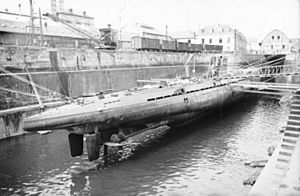German submarine U-40 (1938) facts for kids

U-37, (an identical U-boat to U-40) at Lorient in 1940
|
|
Quick facts for kids History |
|
|---|---|
| Name | U-40 |
| Ordered | 29 July 1936 |
| Builder | DeSchiMAG AG Weser, Bremen |
| Yard number | 945 |
| Laid down | 1 July 1937 |
| Launched | 9 November 1938 |
| Commissioned | 11 February 1939 |
| Fate | Sunk on 13 October 1939 in the English Channel by a mine. 45 men died, three survived |
| General characteristics | |
| Class and type | Type IXA submarine |
| Displacement |
|
| Length |
|
| Beam |
|
| Height | 9.40 m (30 ft 10 in) |
| Draught | 4.70 m (15 ft 5 in) |
| Installed power |
|
| Propulsion |
|
| Range |
|
| Test depth | 230 m (750 ft) |
| Complement | 4 officers, 44 enlisted |
| Armament |
|
| Service record | |
| Part of: |
|
| Identification codes: | M 19 297 |
| Commanders: |
|
| Operations: | Two |
| Victories: | No ships sunk or damaged |
The German submarine U-40 was a large U-boat (a type of submarine) used by Nazi Germany during World War II. It was built in Bremen, Germany, and was ready for service in February 1939.
U-40 went on two missions during the war. It was part of the 6th U-boat Flotilla, a group of submarines. During its short time in service, U-40 did not sink any enemy ships.
Sadly, U-40 was sunk on October 13, 1939. It hit a mine in the English Channel.
Contents
Building the U-40 Submarine
The U-40 was ordered by the German navy, called the Kriegsmarine, on July 29, 1936. Its construction began on July 1, 1937. The submarine was officially launched into the water on November 9, 1938.
It was then fully ready for service on February 11, 1939. Its first commander was Kapitänleutnant Werner von Schmidt.
How U-40 Was Designed
U-40 was one of the first eight Type IX submarines. These were large submarines for their time. When on the surface, U-40 weighed about 1,032 tons. When it was underwater, it weighed about 1,153 tons.
The submarine was about 76.5 meters (251 feet) long. Its main body, called the pressure hull, was about 58.75 meters (192 feet 9 inches) long. It was about 6.51 meters (21 feet 4 inches) wide and 9.40 meters (30 feet 10 inches) tall. The bottom of the submarine sat about 4.70 meters (15 feet 5 inches) deep in the water.
Power and Speed
U-40 used two powerful diesel engines when it was on the surface. These engines gave it about 4,400 horsepower. When underwater, it used two electric motors that provided about 1,000 horsepower. It had two propellers to move through the water.
The submarine could travel up to 18.2 knots (about 33.7 kilometers per hour or 20.9 miles per hour) on the surface. Underwater, its top speed was 7.7 knots (about 14.3 km/h or 8.9 mph).
It could travel a very long distance on the surface, about 10,500 nautical miles (19,400 kilometers or 12,100 miles) at 10 knots. Underwater, it could go about 65 to 78 nautical miles (120 to 144 kilometers or 75 to 90 miles) at 4 knots. U-40 could dive to a depth of about 230 meters (750 feet).
Weapons and Crew
U-40 was well-armed for its missions. It had six torpedo tubes: four at the front and two at the back. It carried 22 torpedoes in total.
For fighting on the surface, it had a large 10.5 cm (4.1 inch) naval gun with 180 rounds of ammunition. It also had anti-aircraft guns to protect against planes. These included a 3.7 cm (1.5 inch) gun and a twin 2 cm (0.79 inch) gun.
The submarine had a crew of 48 people. This included 4 officers and 44 enlisted sailors.
U-40's Missions and Fate
After being made ready for service, U-40 was based in Wilhelmshaven, a German port city. This was its home for its short time in the war.
War Patrols
U-40 began its first mission on August 19, 1939, even before World War II officially started. For almost four weeks, it patrolled near the coast of Gibraltar. It returned to Wilhelmshaven on September 18, 1939.
U-40 left Wilhelmshaven again on October 10, 1939. This time, Kapitänleutnant Wolfgang Barten was in command. The plan was for U-40 to join other U-boats near Portugal and Spain.
The Sinking of U-40
On October 13, 1939, U-40 was sunk by a British mine. The submarine was trying to reach its meeting point southwest of Ireland. Its commander decided to take a shortcut through the English Channel. However, this area was filled with many British naval mines.
The submarine hit one of these mines and quickly sank to the bottom of the sea. Nine crew members managed to escape through the back hatch. They used special escape equipment to reach the surface. Sadly, one of them died on the way up. Once on the surface, five more died from the cold and harsh conditions of the English Channel.
About ten hours after the sinking, the remaining three men were rescued. They were taken as prisoners by the British ship HMS Boreas.

